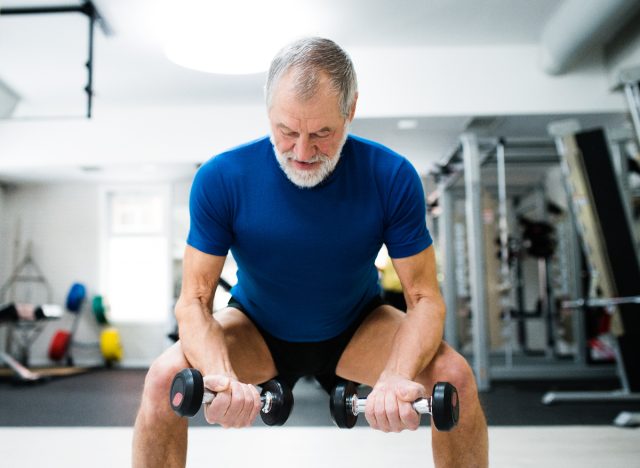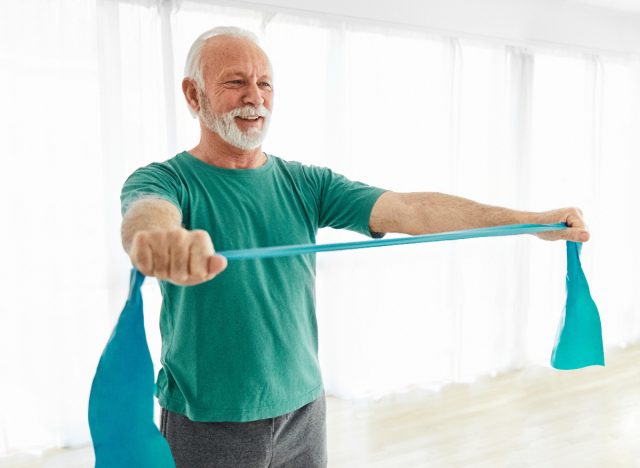5 Top Fitness Tips to Prevent Muscle Loss for Men in Their 60s – Losing lean muscle as you age—also known as sarcopenia—is a common concern many of us stress about. After you hit 30, you can lose anywhere from 3% to 5% of lean muscle mass every decade if you don’t do anything about it. Although this is simply a natural part of growing older, there are things you can start doing today in order to avoid this natural decline or slow it down. Ronny Garcia, CPT, Blink Fitness, shares with us some of the top fitness tips to prevent muscle loss for men in their 60s.

“Staying on top of your supply of lean muscle is important for a variety of reasons, including maintaining strength and functionality,” Garcia tells us. “Lean muscle is directly related to physical strength and functionality. Maintaining muscle mass will help you perform everyday activities. [In addition,] like physical strength, bone health is directly related to muscle mass. Engaging in activities like strength training stimulates both bone growth and density, which in terms reduce the risk of osteoporosis and fractures.”
Some telltale signs to be aware of that you’re losing muscle mass include changes or a decline in your performance or strength, losing muscle tone, a decrease in muscle size, and reduced endurance (aka, feeling more tired when performing exercise). Below, Garcia breaks down the top fitness tips to prevent muscle loss for men in their 60s, so keep reading to learn more. And when you’re finished, don’t miss out on Studies for Long COVID Treatments Are Finally Getting Underway

This may sound like a given, but in order to keep your muscles strong and build upon that strength, you need to work strength training into your regular routine. Whether or not you feel intimidated about working with weights, it’s always a smart idea to consult with a certified fitness professional so they can help curate a personalized routine for you and make sure you’re doing each exercise in the safest way possible.
Garcia recommends performing compound exercises such as squats, bench presses, deadlifts, and rows a minimum of two to three times a week. “Strength training is the most effective way to stimulate muscle growth,” he says.

Making resistance exercises a priority in your routine is another efficient way to strengthen your muscles. Resistance exercises could mean working with resistance bands or weight machines in order to build and preserve your bone density and muscle mass.
Science proves that resistance training is an efficient tool to fight sarcopenia. For instance, research published in Frontiers in Sports and Active Living revealed that eight full weeks of high-speed resistance training resulted in improved functionality and strength gains when compared to traditional training methods among older adults.

When it comes to boosting your muscle strength, your mind automatically goes to lifting weights and working with resistance. But staying fit and in great health in your 40s, 50s, 60s, and beyond calls for a solid balance of strength activities and cardio. So find a cardiovascular exercise you love, and get to it! “Combine your strength training with walking, cycling, or swimming to build a holistic exercise program,” Garcia suggests.

Another fitness tip to prevent muscle loss in your 60s? Emphasize mobility and flexibility in your workout routine. According to the National Institute on Aging, preserving your mobility and avoiding disability is crucial if you want to continue to lead an independent lifestyle as you get older. The way you walk and move may endure changes due to balance, strength, and gait alterations. This can make it more challenging to do the activities and hobbies—like pickleball and swimming—you’re most passionate about. “Incorporating activities like yoga or pilates is beneficial to prevent muscle stiffness and increase overall mobility,” Garcia says.

Performing high-intensity interval training (HIIT) may sound intimidating to those who haven’t done it before. But rest assured, Garcia explains it’s an excellent way to give your metabolism a solid boost, maintain muscle mass, and enhance your cardiovascular health.









